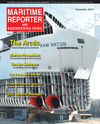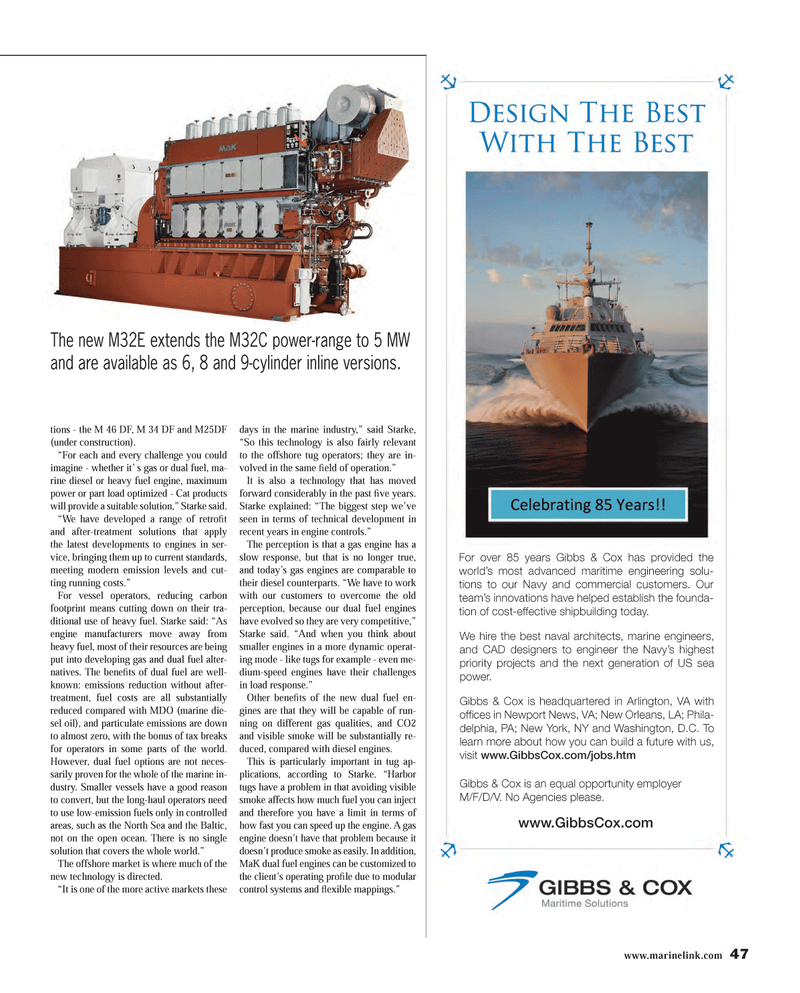
Page 47: of Maritime Reporter Magazine (September 2014)
Marine Propulsion Edition
Read this page in Pdf, Flash or Html5 edition of September 2014 Maritime Reporter Magazine
www.marinelink.com 47
For over 85 years Gibbs & Cox has provided the world’s most advanced maritime engineering solu- tions to our Navy and commercial customers. Our team’s innovations have helped establish the founda- tion of cost-effective shipbuilding today.
We hire the best naval architects, marine engineers, and CAD designers to engineer the Navy’s highest priority projects and the next generation of US sea power.
Gibbs & Cox is headquartered in Arlington, VA with offi ces in Newport News, VA; New Orleans, LA; Phila- delphia, PA; New York, NY and Washington, D.C. To learn more about how you can build a future with us, visit www.GibbsCox.com/jobs.htm
Gibbs & Cox is an equal opportunity employer
M/F/D/V. No Agencies please. www.GibbsCox.com
Gibbs & Cox MRFeb14.indd 1 1/15/2014 1:29:21 PM tions - the M 46 DF, M 34 DF and M25DF (under construction). “For each and every challenge you could imagine - whether it’ s gas or dual fuel, ma- rine diesel or heavy fuel engine, maximum power or part load optimized - Cat products will provide a suitable solution,” Starke said. “We have developed a range of retrofi t and after-treatment solutions that apply the latest developments to engines in ser- vice, bringing them up to current standards, meeting modern emission levels and cut- ting running costs.”
For vessel operators, reducing carbon footprint means cutting down on their tra- ditional use of heavy fuel. Starke said: “As engine manufacturers move away from heavy fuel, most of their resources are being put into developing gas and dual fuel alter- natives. The benefi ts of dual fuel are well- known: emissions reduction without after- treatment, fuel costs are all substantially reduced compared with MDO (marine die- sel oil), and particulate emissions are down to almost zero, with the bonus of tax breaks for operators in some parts of the world.
However, dual fuel options are not neces- sarily proven for the whole of the marine in- dustry. Smaller vessels have a good reason to convert, but the long-haul operators need to use low-emission fuels only in controlled areas, such as the North Sea and the Baltic, not on the open ocean. There is no single solution that covers the whole world.”
The offshore market is where much of the new technology is directed. “It is one of the more active markets these days in the marine industry,” said Starke, “So this technology is also fairly relevant to the offshore tug operators; they are in- volved in the same fi eld of operation.”
It is also a technology that has moved forward considerably in the past fi ve years.
Starke explained: “The biggest step we’ve seen in terms of technical development in recent years in engine controls.”
The perception is that a gas engine has a slow response, but that is no longer true, and today’s gas engines are comparable to their diesel counterparts. “We have to work with our customers to overcome the old perception, because our dual fuel engines have evolved so they are very competitive,”
Starke said. “And when you think about smaller engines in a more dynamic operat- ing mode - like tugs for example - even me- dium-speed engines have their challenges in load response.”
Other benefi ts of the new dual fuel en- gines are that they will be capable of run- ning on different gas qualities, and CO2 and visible smoke will be substantially re- duced, compared with diesel engines.
This is particularly important in tug ap- plications, according to Starke. “Harbor tugs have a problem in that avoiding visible smoke affects how much fuel you can inject and therefore you have a limit in terms of how fast you can speed up the engine. A gas engine doesn’t have that problem because it doesn’t produce smoke as easily. In addition,
MaK dual fuel engines can be customized to the client’s operating profi le due to modular control systems and fl exible mappings.”
The new M32E extends the M32C power-range to 5 MW and are available as 6, 8 and 9-cylinder inline versions.
MR #9 (40-49).indd 47 9/3/2014 11:40:35 AM

 46
46

 48
48
